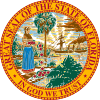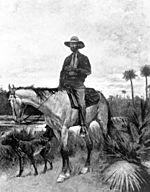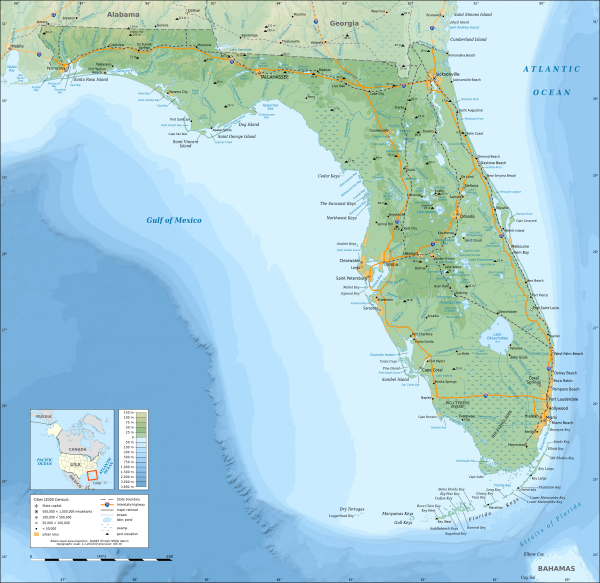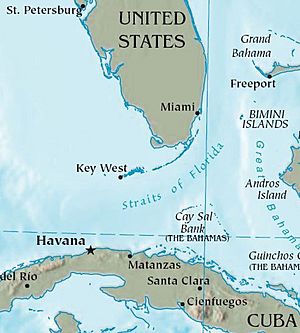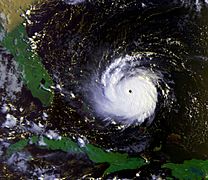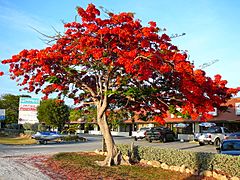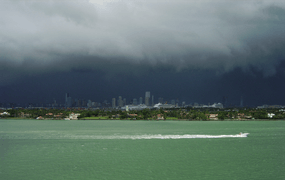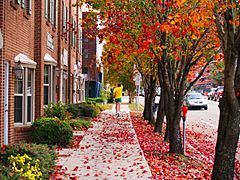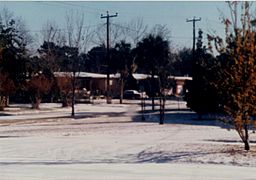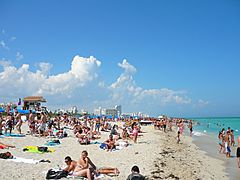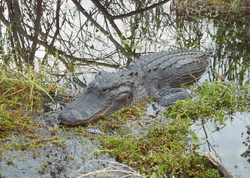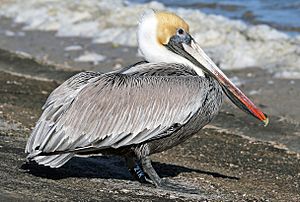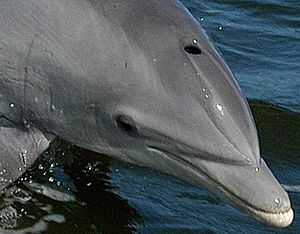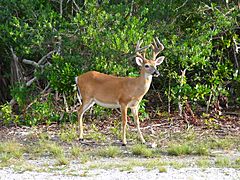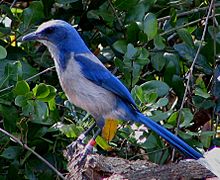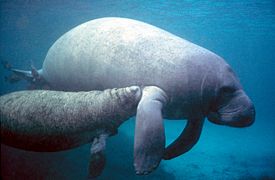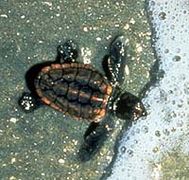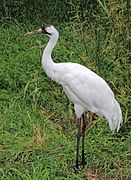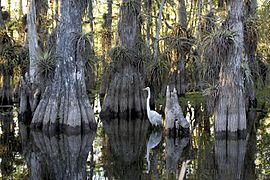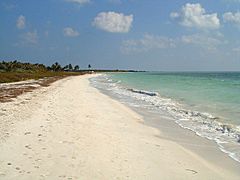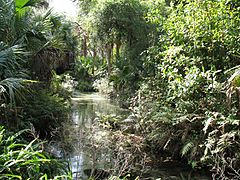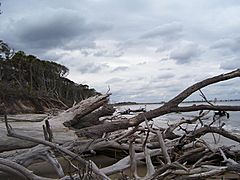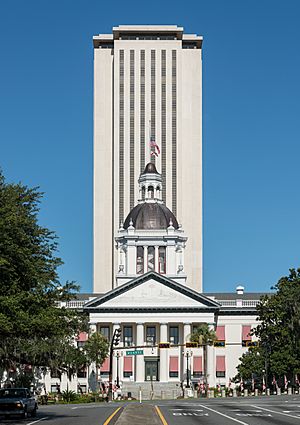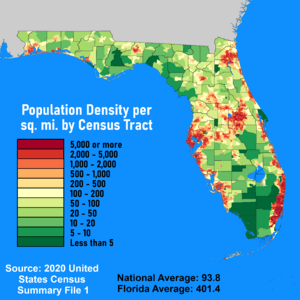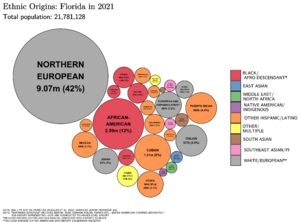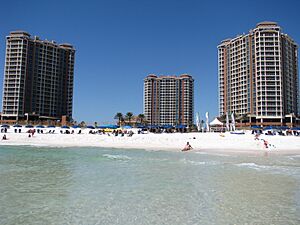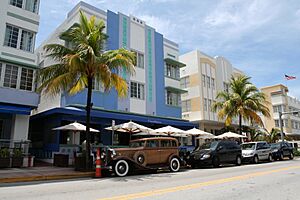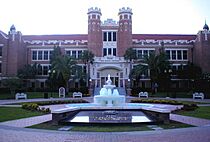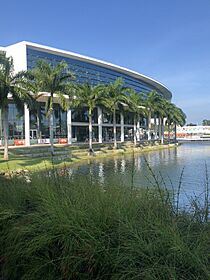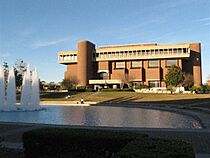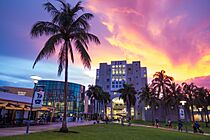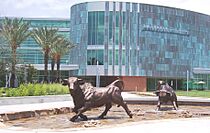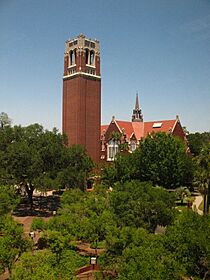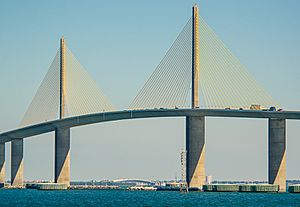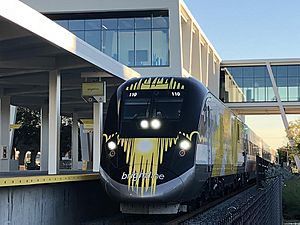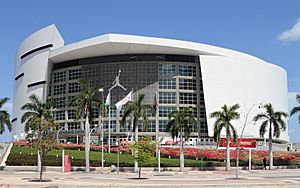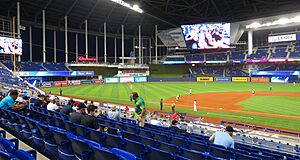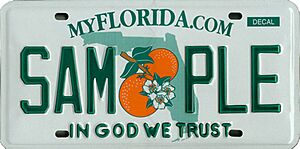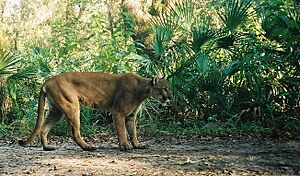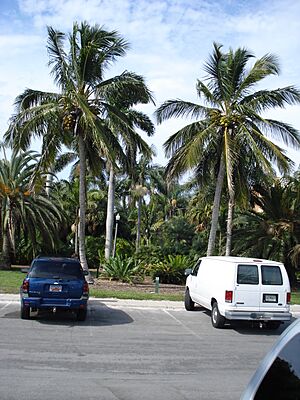Florida facts for kids
Quick facts for kids
Florida
|
|||
|---|---|---|---|
|
|||
| Nickname(s):
Sunshine State
|
|||
| Motto(s): | |||
| Anthem: "Florida" (state anthem), "Old Folks at Home" (state song) | |||

Location of Florida within the United States
|
|||
| Country | United States | ||
| Before statehood | Florida Territory | ||
| Admitted to the Union | March 3, 1845 (27th) | ||
| Capital | Tallahassee | ||
| Largest city | Jacksonville | ||
| Largest county or equivalent | Miami-Dade | ||
| Largest metro and urban areas | South Florida | ||
| Legislature | Florida Legislature | ||
| • Upper house | Senate | ||
| • Lower house | House of Representatives | ||
| Judiciary | Supreme Court of Florida | ||
| U.S. senators | Rick Scott (R) Ashley Moody (R) |
||
| U.S. House delegation | 18 Republicans 8 Democrats 2 vacant (list) |
||
| Area | |||
| • Total | 65,758 sq mi (170,312 km2) | ||
| • Land | 53,625 sq mi (138,887 km2) | ||
| • Water | 12,133 sq mi (31,424 km2) 18.5% | ||
| Area rank | 22nd | ||
| Dimensions | |||
| • Length | 447 mi (721 km) | ||
| • Width | 361 mi (582 km) | ||
| Elevation | 100 ft (30 m) | ||
| Highest elevation | 345 ft (105 m) | ||
| Lowest elevation
(Atlantic Ocean)
|
0 ft (0 m) | ||
| Population
(2024)
|
|||
| • Total | |||
| • Rank | 3rd | ||
| • Density | 414.8/sq mi (160/km2) | ||
| • Density rank | 7th | ||
| • Median household income | $73,300 (2023) | ||
| • Income rank | 34th | ||
| Demonym(s) | Floridian, Floridan | ||
| Language | |||
| • Official language | English | ||
| • Spoken language | |||
| Time zones | |||
| Peninsula and "Big Bend" region | UTC−05:00 (Eastern) | ||
| • Summer (DST) | UTC−04:00 (EDT) | ||
| Panhandle west of the Apalachicola River | UTC−06:00 (Central) | ||
| • Summer (DST) | UTC−05:00 (CDT) | ||
| USPS abbreviation |
FL
|
||
| ISO 3166 code | US-FL | ||
| Traditional abbreviation | Fla. | ||
| Latitude | 24° 27' N to 31° 00' N | ||
| Longitude | 80° 02' W to 87° 38' W | ||
| Bird | Northern mockingbird |
|---|---|
| Fish | Florida largemouth bass, Atlantic sailfish |
| Flower | Orange blossom |
| Tree | Sabal palmetto |
| Insect | Zebra longwing |
Florida (/ˈflɒrɪdə/ florr-IH-də) is a state in the Southeastern region of the United States. It borders the Gulf of Mexico to the west, Alabama to the northwest, Georgia to the north, the Atlantic Ocean to the east, and the Straits of Florida and Cuba to the south. About two-thirds of Florida occupies a peninsula between the Gulf of Mexico and the Atlantic Ocean. It has the longest coastline in the contiguous United States, spanning approximately 1,350 miles (2,170 km), not including its many barrier islands. It is the only state that borders both the Gulf of Mexico and the Atlantic Ocean. With a population of over 21 million, it is the third-most populous state in the United States and ranks eighth in population density as of 2020. Florida spans 65,758 square miles (170,310 km2), ranking 22nd in area among the states. The Miami metropolitan area, anchored by the cities of Miami, Fort Lauderdale, and West Palm Beach, is the state's largest metropolitan area, with a population of 6.138 million; the most populous city is Jacksonville. Florida's other major population centers include Tampa Bay, Orlando, Cape Coral, and the state capital of Tallahassee.
Various American Indian tribes have inhabited Florida for at least 14,000 years. In 1513, Spanish explorer Juan Ponce de León became the first known European to make landfall, calling the region La Florida (land of flowers) ([la floˈɾiða]). Florida subsequently became the first area in the continental U.S. to be permanently settled by Europeans, with the settlement of St. Augustine, founded in 1565, being the oldest continuously inhabited city. Florida was a Spanish territory frequently attacked and coveted by Great Britain before Spain ceded it to the U.S. in 1819 in exchange for resolving the border dispute along the Sabine River in Spanish Texas. Florida was admitted as the 27th state on March 3, 1845, and was the principal location of the Seminole Wars (1816–1858), the longest and most extensive of the American Indian Wars. The state seceded from the Union on January 10, 1861, becoming one of the seven original Confederate States, and was readmitted to the Union after the Civil War on June 25, 1868.
Since the mid-20th century, Florida has experienced rapid demographic and economic growth. Its economy, with a gross state product (GSP) of $1.4 trillion, is the fourth largest of any U.S. state and the 16th-largest in the world; the main sectors are tourism, hospitality, agriculture, real estate, and transportation. Florida is world-renowned for its beach resorts, amusement parks, warm and sunny climate, and nautical recreation; attractions such as Walt Disney World, the Kennedy Space Center, and Miami Beach draw tens of millions of visitors annually. Florida is a popular destination for retirees, seasonal vacationers, and both domestic and international migrants; it hosts nine out of the ten fastest-growing communities in the U.S. The state's close proximity to the ocean has shaped its culture, identity, and daily life; its colonial history and successive waves of migration are reflected in African, European, Indigenous, Latino, and Asian influences. Florida has attracted or inspired some of the most prominent American writers, including Ernest Hemingway, Marjorie Kinnan Rawlings, and Tennessee Williams, and continues to attract celebrities and athletes, especially in golf, tennis, auto racing, and water sports. Florida has been considered a battleground state in American presidential elections, particularly those in 2000 and 2016.
Florida's climate varies from subtropical in the north to tropical in the south. It is the only state besides Hawaii to have a tropical climate, and the only continental state with both a tropical climate, located at the southern portion of the state, and a coral reef. Florida has several unique ecosystems, including Everglades National Park, the largest tropical wilderness in the U.S. and among the largest in the Americas. Unique wildlife include the American alligator, American crocodile, American flamingo, Roseate spoonbill, Florida panther, bottlenose dolphin, and manatee. The Florida Reef is the only living coral barrier reef in the continental United States, and the third-largest coral barrier reef system in the world, after the Great Barrier Reef and the Belize Barrier Reef.
Contents
History

By the 16th century, the earliest time for which there is a historical record, major Native American groups included the Apalachee (of the Florida Panhandle), the Timucua (of northern and central Florida), the Ais (of the central Atlantic coast), the Tocobaga (of the Tampa Bay area), the Calusa (of southwest Florida) and the Tequesta (of the southeastern coast).
Florida was the first part of the continental United States to be visited and settled by Europeans. The earliest known European explorers came with the Spanish conquistador Juan Ponce de León. Ponce de León spotted and landed on the peninsula on April 2, 1513. He named the region La Florida ("land of flowers"). The story that he was searching for the Fountain of Youth is a myth.
A lot of south Florida used to be covered by a swamp called the Everglades. When Florida was first being settled, farmers found out the soil there was very good for growing plants. So they could use more of the land to plant, they drained a lot of the water away in 1882. In 1947, the state put in levees and canals to make more room for farming and houses. The Everglades is now about half the size it used to be. Most of what is left is now the Everglades National Park. Lots of animals live there, including alligators and Florida panthers. Recently, Florida has been trying to restore the Everglades.
In 1763, Spain traded Florida to the Kingdom of Great Britain for control of Havana, Cuba, which had been captured by the British during the Seven Years' War. It was part of a large expansion of British territory following their victory in the Seven Years' War.
On March 3, 1845, Florida became the 27th state to join the United States of America. The state was admitted as a slave state and ceased to be a sanctuary for runaway slaves.
Until the mid-20th century, Florida was the least populous Southern state. In 1900 its population was only 528,542, of whom nearly 44% were African American, the same proportion as before the Civil War. The boll weevil devastated cotton crops.
Forty thousand blacks, roughly one-fifth of their 1900 population, left the state in the Great Migration.
Historically, Florida's economy was based upon agricultural products such as cattle farming, sugarcane, citrus, tomatoes, and strawberries.
Economic prosperity in the 1920s stimulated tourism to Florida and related development of hotels and resort communities.
With a population of more than 18 million according to the 2010 census, Florida is the most populous state in the Southeastern United States, and the fourth most populous in the United States.
-
Laura Street in Downtown Jacksonville
-
The Florida House on Capitol Hill, or "embassy of Florida" in D.C.
-
Historic Ybor City in Tampa
-
The Downtown Miami Historic District has some of the oldest buildings in Miami
Geography
Much of the state of Florida is situated on a peninsula between the Gulf of Mexico, the Atlantic Ocean and the Straits of Florida. Spanning two time zones, it extends to the northwest into a panhandle, extending along the northern Gulf of Mexico. It is bordered on the north by the states of Georgia and Alabama, and on the west, at the end of the panhandle, by Alabama. It is the only state that borders both the Atlantic Ocean and Gulf of Mexico.
Florida is west of The Bahamas and 90 miles (140 km) north of Cuba. Florida is one of the largest states east of the Mississippi River, and only Alaska and Michigan are larger in water area. The water boundary is 3 nautical miles (3.5 mi; 5.6 km) offshore in the Atlantic Ocean and 9 nautical miles (10 mi; 17 km) offshore in the Gulf of Mexico.
At 345 feet (105 m) above mean sea level, Britton Hill is the highest point in Florida and the lowest highpoint of any U.S. state. Much of the state south of Orlando lies at a lower elevation than northern Florida, and is fairly level. Much of the state is at or near sea level.
On average, Florida is the flattest state in the United States.
Climate
The climate of Florida is a humid subtropical, while areas south of the lake (including the Florida Keys) have a true tropical climate.
Due to its subtropical and tropical climate, Florida rarely receives snow. However, on rare occasions, a combination of cold moisture and freezing temperatures can result in snowfall in the farthest northern regions. Frost is more common than snow, occurring sometimes in the panhandle.
Florida's nickname is the "Sunshine State", but severe weather is a common occurrence in the state.
Central Florida is known as the lightning capital of the United States, as it experiences more lightning strikes than anywhere else in the U.S. Florida has one of the highest average precipitation levels of any state, in large part because afternoon thunderstorms are common in much of the state from late spring until early autumn.
Florida leads the United States in tornadoes per area (when including waterspouts) but they do not typically reach the intensity of those in the Midwest and Great Plains. Hail often accompanies the most severe thunderstorms.
Hurricanes pose a severe threat each year during the June 1 to November 30 hurricane season, particularly from August to October. Florida is the most hurricane-prone state, with subtropical or tropical water on a lengthy coastline.
Florida was the site of one of the costliest weather disasters in U.S. history, Hurricane Andrew, which caused more than $25 billion in damage when it struck in August 1992.
-
Hurricane Andrew bearing down on Florida on August 23, 1992.
-
The Royal Poinciana grows in South Florida and blooms in the winter, an indication of South Florida's tropical climate
-
Summer afternoon showers from the Everglades traveling eastward over Downtown Miami
-
Fall foliage occurs annually in North Florida.
Fauna
Florida is host to many types of wildlife including:
- Marine mammals: bottlenose dolphin, short-finned pilot whale, North Atlantic right whale, West Indian manatee
- Mammals: Florida panther, northern river otter, mink, eastern cottontail rabbit, marsh rabbit, raccoon, striped skunk, squirrel, white-tailed deer, Key deer, bobcats, gray fox, coyote, wild boar, Florida black bear, nine-banded armadillos, Virginia opossum
- Reptiles: eastern diamondback and pygmy rattlesnakes, gopher tortoise, green and leatherback sea turtles, and eastern indigo snake. In 2012, there were about one million American alligators and 1,500 crocodiles.
- Birds: peregrine falcon, bald eagle, northern caracara, snail kite, osprey, white and brown pelicans, sea gulls, whooping and sandhill cranes, roseate spoonbill, Florida scrub jay (state endemic), and others. One subspecies of wild turkey, Meleagris gallopavo, namely subspecies osceola, is found only in Florida. The state is a wintering location for many species of eastern North American birds.
- As a result of climate change, there have been small numbers of several new species normally native to cooler areas to the north: snowy owls, snow buntings, harlequin ducks, and razorbills. These have been seen in the northern part of the state.
- Invertebrates: carpenter ants, termites, American cockroach, Africanized bees, the Miami blue butterfly, and the grizzled mantis.
The only known calving area for the northern right whale is off the coasts of Florida and Georgia.
The native bear population has risen from a historic low of 300 in the 1970s, to 3,000 in 2011.
Since their accidental importation from South America into North America in the 1930s, the red imported fire ant population has increased its territorial range to include most of the Southern United States, including Florida. They are more aggressive than most native ant species and have a painful sting.
A number of non-native snakes and lizards have been released in the wild. In 2010 the state created a hunting season for Burmese and Indian pythons, African rock pythons, green anacondas, and Nile monitor lizards. Green iguanas have also established a firm population in the southern part of the state.
There are about 500,000 feral pigs in Florida.
-
Key deer in the lower Florida Keys
-
The Florida scrub jay is found only in Florida.
-
Florida panther, native of South Florida
Flora
There are about 3,000 different types of wildflowers in Florida. This is the third most diverse state in the union, behind California and Texas, both larger states.
On the east coast of the state, mangroves have normally dominated the coast from Cocoa Beach southward; salt marshes from St. Augustine northward. From St. Augustine south to Cocoa Beach, the coast fluctuates between the two, depending on the annual weather conditions.
-
Bahia Honda in the Florida Keys
Environmental issues
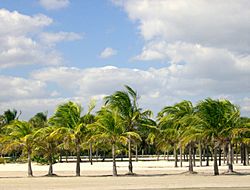
Red tide has been an issue on the southwest coast of Florida, as well as other areas. While there has been a great deal of conjecture over the cause of the toxic algae bloom, there is no evidence that it is being caused by pollution or that there has been an increase in the duration or frequency of red tides.
The Florida panther is close to extinction.
Much of Florida has an elevation of less than 12 feet (3.7 m), including many populated areas. Therefore, it is susceptible to rising sea levels associated with global warming.
Government
The basic structure, duties, function, and operations of the government of the State of Florida are defined by the Florida Constitution, which establishes the basic law of the state and guarantees various rights and freedoms of the people. As with the American federal government and all other state governments, Florida's government consists of three separate branches: executive, legislative, and judicial. The legislature enacts bills, which, if signed by the governor, become law.
The Florida Legislature comprises the Florida Senate, which has 40 members, and the Florida House of Representatives, which has 120 members. The governor of Florida is Ron DeSantis. The Florida Supreme Court consists of a chief justice and six justices.
Florida has 67 counties. Some reference materials may show only 66 because Duval County is consolidated with the City of Jacksonville. There are 379 cities in Florida (out of 411) that report regularly to the Florida Department of Revenue, but there are other incorporated municipalities that do not. The primary revenue source for cities and counties is property tax; properties with unpaid taxes are subject to tax sales, which are held at the county level in May and are highly popular, due to the extensive use of online bidding sites.
The state government's primary revenue source is sales tax. Florida is one of eight states that do not impose a personal income tax.
Florida retains the death penalty.
Demographics
Population
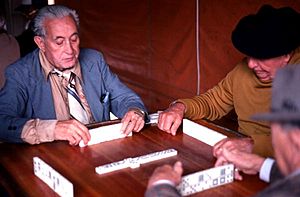
| Historical population | |||
|---|---|---|---|
| Census | Pop. | %± | |
| 1830 | 34,730 | — | |
| 1840 | 54,477 | 56.9% | |
| 1850 | 87,445 | 60.5% | |
| 1860 | 140,424 | 60.6% | |
| 1870 | 187,748 | 33.7% | |
| 1880 | 269,493 | 43.5% | |
| 1890 | 391,422 | 45.2% | |
| 1900 | 528,542 | 35.0% | |
| 1910 | 752,619 | 42.4% | |
| 1920 | 968,470 | 28.7% | |
| 1930 | 1,468,211 | 51.6% | |
| 1940 | 1,897,414 | 29.2% | |
| 1950 | 2,771,305 | 46.1% | |
| 1960 | 4,951,560 | 78.7% | |
| 1970 | 6,789,443 | 37.1% | |
| 1980 | 9,746,324 | 43.6% | |
| 1990 | 12,937,926 | 32.7% | |
| 2000 | 15,982,378 | 23.5% | |
| 2010 | 18,801,310 | 17.6% | |
| 2020 | 21,538,187 | 14.6% | |
| 2023 (est.) | 22,610,726 | 20.3% | |
| Sources: 1910–2020 | |||
The U.S. Census Bureau estimated that the population of Florida was 21,477,737 on July 1, 2019, a 14.24% increase since the 2010 United States census. The population of Florida in the 2010 census was 18,801,310. Florida was the seventh fastest-growing state in the U.S. in the 12-month period ending July 1, 2012. In 2010, the center of population of Florida was located between Fort Meade and Frostproof. The center of population has moved less than 5 miles (8 km) to the east and approximately 1 mile (1.6 km) to the north between 1980 and 2010 and has been located in Polk County since the 1960 census. The population exceeded 19.7 million by December 2014, surpassing the population of the state of New York for the first time, making Florida the third most populous state. The Florida population was 21,477,737 residents or people according to the U.S. Census Bureau's 2019 Population Estimates Program. By the 2020 census, its population increased to 21,538,187.
In 2010, undocumented immigrants constituted an estimated 5.7% of the population. This was the sixth highest percentage of any U.S. state. There were an estimated 675,000 illegal immigrants in the state in 2010. Florida has banned sanctuary cities.
The top countries of origin for Florida's immigrants were Cuba, Haiti, Colombia, Mexico and Jamaica in 2018.
According to HUD's 2022 Annual Homeless Assessment Report, there were an estimated 25,959 homeless people in Florida.
| Racial composition | 1970 | 1990 | 2000 | 2010 | 2020 |
|---|---|---|---|---|---|
| Hispanic or Latino (of any race) | 6.6% | 12.2% | 16.8% | 22.5% | 26.5% |
| Black or African American alone | 15.3% | 13.6% | 14.6% | 16.0% | 15.1% |
| Asian alone | 0.2% | 1.2% | 1.7% | 2.4% | 3.0% |
| Native American alone | 0.1% | 0.3% | 0.3% | 0.4% | 0.4% |
| Two or more races | — | — | 2.3% | 2.5% | 16.5% |
| White alone, not Hispanic or Latino | 77.9% | 73.2% | 65.4% | 57.9% | 51.5% |
| White alone | 84.2% | 83.1% | 78.0% | 75.0% | 57.7% |
In 2010, 6.9% of the population (1,269,765) considered themselves to be of only American ancestry (regardless of race or ethnicity). Many of these were of English or Scotch-Irish descent, whose families have lived in the state for so long they choose to identify as having "American" ancestry or do not know their ancestry. In the 1980 United States census, the largest ancestry group reported in Florida was English with 2,232,514 Floridians claiming they were of English or mostly English American ancestry. Some of their ancestry dated to the original thirteen colonies.
As of 2010[update], those of (non-Hispanic white) European ancestry accounted for 57.9% of Florida's population. Out of the 57.9%, the largest groups were 12.0% German (2,212,391), 10.7% Irish (1,979,058), 8.8% English (1,629,832), 6.6% Italian (1,215,242), 2.8% Polish (511,229), and 2.7% French (504,641). White Americans of all European backgrounds are present in all areas of the state. In 1970, non-Hispanic whites constituted nearly 80% of Florida's population. Those of English and Irish ancestry are present in large numbers in all the urban/suburban areas across the state. Some native white Floridians, especially those who have descended from long-time Florida families, may refer to themselves as "Florida crackers"; others see the term as a derogatory one. Like whites in most other states of the southern U.S., they descend mainly from English and Scots-Irish settlers, as well as some other British American settlers.
As of 2010, those of Hispanic or Latino ancestry accounted for 22.5% (4,223,806) of Florida's population. Out of the 22.5%, the largest groups were 6.5% (1,213,438) Cuban, and 4.5% (847,550) Puerto Rican. Florida's Hispanic population includes large communities of Cuban Americans in Miami and Tampa, Puerto Ricans in Orlando and Tampa, and Mexican/Central American migrant workers. The Hispanic community continues to grow more affluent and mobile. Florida has a large and diverse Hispanic population, with Cubans and Puerto Ricans being the largest groups in the state. Nearly 80% of Cuban Americans live in Florida, especially South Florida where there is a long-standing and affluent Cuban community. Florida has the second-largest Puerto Rican population after New York, as well as the fastest-growing in the U.S. Puerto Ricans are more widespread throughout the state, though the heaviest concentrations are in the Orlando area of Central Florida. Florida has one of the largest and most diverse Hispanic/Latino populations in the country, especially in South Florida around Miami, and to a lesser degree Central Florida. Aside from the dominant Cuban and Puerto Rican populations, there are also large populations of Mexicans, Colombians, Venezuelans and Dominicans, among numerous other groups, as most Latino groups have sizable numbers in the state.
As of 2010[update], those of African ancestry accounted for 16.0% of Florida's population, which includes African Americans. Out of the 16.0%, 4.0% (741,879) were West Indian or Afro-Caribbean American. During the early 1900s, black people made up nearly half of the state's population. In response to segregation, disfranchisement and agricultural depression, many African Americans migrated from Florida to northern cities in the Great Migration, in waves from 1910 to 1940, and again starting in the later 1940s. They moved for jobs, better education for their children and the chance to vote and participate in society. By 1960, the proportion of African Americans in the state had declined to 18%. Conversely, large numbers of northern whites moved to the state. Today, large concentrations of black residents can be found throughout Florida. Aside from blacks descended from African slaves brought to the southern U.S., there are also large numbers of blacks of West Indian, recent African, and Afro-Latino immigrant origins, especially in the Miami/South Florida area. Florida has the largest West Indian population of any state, originating from many Caribbean countries, with Haitian Americans being the most numerous.
In 2016, Florida had the highest percentage of West Indians in the United States at 4.5%, with 2.3% (483,874) from Haitian ancestry, 1.5% (303,527) Jamaican, and 0.2% (31,966) Bahamian, with the other West Indian groups making up the rest.
As of 2010[update], those of Asian ancestry accounted for 2.4% of Florida's population.
As of 2011, Florida contains the highest percentage of people over 65 (17.3%) in the U.S. There were 186,102 military retirees living in the state in 2008. About two-thirds of the population was born in another state, the second-highest in the U.S.
In 2020, Hispanic and Latinos of any race(s) made up 26.5% of the population, while Native Hawaiians and Pacific Islanders made up 0.1% of all Broward County residents.
Languages
In 1988, English was affirmed as the state's official language in the Florida Constitution. Spanish is also widely spoken, especially as immigration has continued from Latin America. About twenty percent of the population speak Spanish as their first language. Twenty-seven percent of Florida's population reports speaking a mother language other than English, and more than 200 first languages other than English are spoken at home in the state.
The most common languages spoken in Florida as a first language in 2010 are:
- 73% English
- 20% Spanish
- 2% Haitian Creole
- Other languages less than 1% each
Religion
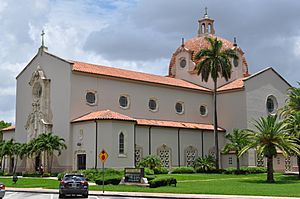
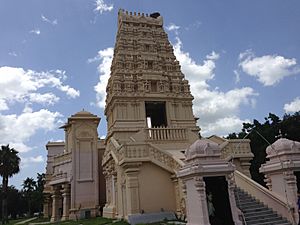
Florida is mostly Christian (70%), although there is a large irreligious and relatively significant Jewish community. Protestants account for almost half of the population, but the Catholic Church is the largest single denomination in the state mainly due to its large Hispanic population and other groups like Haitians. Protestants are very diverse, although Baptists, Methodists, Pentecostals and nondenominational Protestants are the largest groups. Smaller Christian groups include The Church of Jesus Christ of Latter-day Saints and Jehovah's Witness. There is also a sizable Jewish community in South Florida. This is the largest Jewish population in the southern U.S. and the third-largest in the U.S. behind those of New York and California.
In 2010, the three largest denominations in Florida were the Catholic Church, the Southern Baptist Convention, and the United Methodist Church.
The Pew Research Center survey in 2014 gave the following religious makeup of Florida:
| Religion in Florida (2014) | ||||
|---|---|---|---|---|
| Protestant | 46% | |||
| Catholic | 21% | |||
| Mormon | 1% | |||
| Jehovah's Witness | 1% | |||
| Other Christian | 1% | |||
| Nothing in Particular | 17% | |||
| Agnostic | 4% | |||
| Atheist | 3% | |||
| Jewish | 3% | |||
| Other faiths (e.g. Hinduism, Islam, Buddhism, Sikhism) |
3% | |||
Economy

The economy of the state of Florida is the fourth-largest in the United States, with a $1.2 trillion gross state product (GSP) as of 2021. If Florida were a sovereign nation (2021), it would rank as the world's 16th-largest economy according to the International Monetary Fund, ahead of Indonesia and behind Mexico. In the 20th century, tourism, industry, construction, international banking, biomedical and life sciences, healthcare research, simulation training, aerospace and defense, and commercial space travel have contributed to the state's economic development.
Tourism is a large portion of Florida's economy. Florida is home to the world's most visited theme park, the Magic Kingdom. Florida is also home to the largest single-site employer in the United States, Walt Disney World. PortMiami is the largest passenger port in the world and one of the largest cargo ports in the United States. Beach towns have many visitors too as Florida is known around the world for its beaches.
Agriculture is another large part of the Florida economy. Florida is the number one grower of oranges for juice, mangoes, fresh tomatoes, sugar, sweet corn, green beans, beans, cucumbers, watermelons, and more. Florida is also the second biggest producer of strawberries, avocadoes, grapefruit, and peppers in the U.S.
Other large sectors of Florida's economy include finance, government and military (especially in Jacksonville and Pensacola), healthcare, aerospace (especially in the Space Coast), mining (especially for phosphate in Bone Valley), fishing, trade, real estate, and tech (especially in Miami, Orlando, and Tampa in the 2020s).
Healthcare
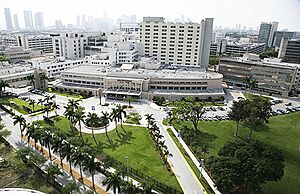
There were 2.7 million Medicaid patients in Florida in 2009. The governor has proposed adding $2.6 billion to care for the expected 300,000 additional patients in 2011. The cost of caring for 2.3 million clients in 2010 was $18.8 billion. This is nearly 30% of Florida's budget. Medicaid paid for 60% of all births in Florida in 2009. The state has a program for those not covered by Medicaid.
In 2013, Florida refused to participate in providing coverage for the uninsured under the Affordable Care Act, colloquially called Obamacare. The Florida legislature also refused to accept additional Federal funding for Medicaid, although this would have helped its constituents at no cost to the state. As a result, Florida is second only to Texas in the percentage of its citizens without health insurance.
In 2022, the largest hospital network in Florida is HCA Healthcare and the second largest is AdventHealth. In 2023, the largest hospitals in Florida were Jackson Memorial Hospital, AdventHealth Orlando, Tampa General Hospital, UF Health Shands Hospital and Baptist Hospital of Miami.
Mayo Clinic hosts one of its three major U.S. campuses in Jacksonville. The practice specializes in treating difficult cases through tertiary care and destination medicine.
Architecture
Florida has the largest collection of Art Deco and Streamline Moderne buildings, both in the United States and in the entire world, most of which are located in the Miami metropolitan area, especially Miami Beach's Art Deco District, constructed as the city was becoming a resort destination. A unique architectural design found only in Florida is the post-World War II Miami Modern, which can be seen in areas such as Miami's MiMo Historic District.
Being of early importance as a regional center of banking and finance, the architecture of Jacksonville displays a wide variety of styles and design principles. Many of the state's earliest skyscrapers were constructed in Jacksonville, dating as far back as 1902, and last holding a state height record from 1974 to 1981. The city is endowed with one of the largest collections of Prairie School buildings outside of the Midwest. Jacksonville is also noteworthy for its collection of Mid-Century modern architecture.
Some sections of the state feature architectural styles including Spanish revival, Florida vernacular, and Mediterranean Revival. A notable collection of these styles can be found in St. Augustine, the oldest continuously occupied European-established settlement within the borders of the United States.
Education
In 2020, Florida was ranked the third best state in the U.S. for K-12 education, outperforming other states in 15 out of 18 metrics in Education Week's 2020 Quality Counts report. In terms of K-12 Achievement, which measures progress in areas such as academic excellence and graduation rates, the state was graded "B−" compared to a national average of C. Florida's higher education was ranked first and pre-K-12 was ranked 27th best nationwide by U.S. News & World Report.
Primary and secondary education
Florida spent $8,920 for each student in 2016, and was 43rd in the U.S. in expenditures per student.
Florida's primary and secondary school systems are administered by the Florida Department of Education. School districts are organized within county boundaries. Each school district has an elected Board of Education that sets policy, budget, goals, and approves expenditures. Management is the responsibility of a Superintendent of schools.
The Florida Department of Education is required by law to train educators in teaching English for Speakers of Other Languages (ESOL).
While Florida's public schools suffer from more than 5,000 unoccupied teacher positions, according to Karla Hernández, teacher and president of United Teachers of Dade, decisions made by the DeSantis administration will make the situation worse. She referred to its blocking of an Advanced Placement African American studies course, book bans and removing some lessons in courses as "really scary moments in the state of Florida".
In 2023, the state of Florida approved a public school curriculum including videos produced by conservative advocacy group PragerU, likening climate change skeptics to those who fought Communism and Nazism, implying renewable energy harms the environment, and saying global warming occurs naturally. DeSantis has called climate change "leftwing stuff".
In August 2023, restrictions have been placed on the teaching of Shakespearean plays and literature by Florida teachers in order to comply with state law.
Higher education
The State University System of Florida was founded in 1905, and is governed by the Florida Board of Governors. During the 2019 academic year, 346,604 students attended one of these twelve universities. In 2016, Florida charged the second lowest tuition in the U.S. for four-year programs, at $26,000 for in-state students and $86,000 for out-of-state students; this compares with an average of $34,800 for in-state students.
As of 2020, three Florida universities are among the top 10 largest universities by enrollment in the United States: The University of Central Florida in Orlando (2nd), the University of Florida in Gainesville (4th), and Florida International University in Miami (8th).
The Florida College System comprises 28 public community and state colleges with 68 campuses spread out throughout the state. In 2016, enrollment exceeded 813,000 students.
The Independent Colleges and Universities of Florida is an association of 30 private, educational institutions in the state. This Association reported that their member institutions served more than 158,000 students in the fall of 2020.
The University of Miami in Coral Gables is one of the top private research universities in the U.S. Florida's first private university, Stetson University in DeLand, was founded in 1883.
As of 2023, three universities in Florida are members of the Association of American Universities: University of Florida, University of Miami and University of South Florida.
Transportation
Highways
Florida's highway system contains 1,495 mi (2,406 km) of interstate highway, and 10,601 mi (17,061 km) of non-interstate highway, such as state highways and U.S. Highways. Florida's interstates, state highways, and U.S. Highways are maintained by the Florida Department of Transportation.
In 2011, there were about 9,000 retail gas stations in the state. Floridians consumed 21 million gallons of gasoline daily in 2011, ranking it third in national use behind California and Texas. As of 2024, motorists in Florida have one of the highest rates of car insurance in the U.S. 24% are uninsured.
Drivers between 15 and 19 years of age averaged 364 car crashes a year per ten thousand licensed Florida drivers in 2010. Drivers 70 and older averaged 95 per 10,000 during the same time frame. A spokesperson for the non-profit Insurance Institute stated "Older drivers are more of a threat to themselves."
Intercity bus travel, which utilizes Florida's highway system, is provided by Greyhound, Megabus, and Amtrak Thruway.
Before the construction of routes under the Federal Aid Highway Act of 1956, Florida began construction of a long cross-state toll road, Florida's Turnpike. The first section, from Fort Pierce south to the Golden Glades Interchange was completed in 1957. After a second section north through Orlando to Wildwood (near present-day The Villages), and a southward extension around Miami to Homestead, it was finished in 1974.
Florida's primary interstate routes include:
 I-4, which spans 133 miles, bisects the state, connecting Tampa, Lakeland, Orlando, and Daytona Beach, connecting with I-75 in Tampa and I-95 in Daytona Beach.
I-4, which spans 133 miles, bisects the state, connecting Tampa, Lakeland, Orlando, and Daytona Beach, connecting with I-75 in Tampa and I-95 in Daytona Beach. I-10, which spans 362 miles in Florida, traverses the panhandle, connecting Pensacola, Tallahassee, Lake City, and Jacksonville, with interchanges with I-75 in Lake City and I-95 in Jacksonville. It is the southernmost east–west interstate in the United States terminating in Santa Monica with a total length of 2460 miles.
I-10, which spans 362 miles in Florida, traverses the panhandle, connecting Pensacola, Tallahassee, Lake City, and Jacksonville, with interchanges with I-75 in Lake City and I-95 in Jacksonville. It is the southernmost east–west interstate in the United States terminating in Santa Monica with a total length of 2460 miles. I-75, which spans 470 miles in Florida, enters the state near Lake City (45 miles (72 km) west of Jacksonville) and continues southward through Gainesville, Ocala, Tampa's eastern suburbs, Bradenton, Sarasota, Fort Myers and Naples, where it crosses the "Alligator Alley" as a toll road to Fort Lauderdale before turning southward and terminating in Hialeah/Miami Lakes having interchanges with I-10 in Lake City and I-4 in Tampa. It is the second longest north–south interstate with a total length of 1786 miles and terminates at the Canadian border at Sault Ste. Marie, Michigan.
I-75, which spans 470 miles in Florida, enters the state near Lake City (45 miles (72 km) west of Jacksonville) and continues southward through Gainesville, Ocala, Tampa's eastern suburbs, Bradenton, Sarasota, Fort Myers and Naples, where it crosses the "Alligator Alley" as a toll road to Fort Lauderdale before turning southward and terminating in Hialeah/Miami Lakes having interchanges with I-10 in Lake City and I-4 in Tampa. It is the second longest north–south interstate with a total length of 1786 miles and terminates at the Canadian border at Sault Ste. Marie, Michigan. I-95, which spans 382 miles in Florida, enters the state near Jacksonville and continues along the Atlantic Coast through Daytona Beach, the Melbourne/Titusville, Palm Bay, Vero Beach, Fort Pierce, Port Saint Lucie, Stuart, West Palm Beach, and Fort Lauderdale, before terminating in Downtown Miami. It has interchanges with I-10 in Jacksonville and I-4 in Daytona Beach, and there are four auxiliary routes associated with the interstate. It is the longest north–south interstate with a total length of 1924 miles and terminates at the Canadian border northeast of Houlton, Maine.
I-95, which spans 382 miles in Florida, enters the state near Jacksonville and continues along the Atlantic Coast through Daytona Beach, the Melbourne/Titusville, Palm Bay, Vero Beach, Fort Pierce, Port Saint Lucie, Stuart, West Palm Beach, and Fort Lauderdale, before terminating in Downtown Miami. It has interchanges with I-10 in Jacksonville and I-4 in Daytona Beach, and there are four auxiliary routes associated with the interstate. It is the longest north–south interstate with a total length of 1924 miles and terminates at the Canadian border northeast of Houlton, Maine.
Airports
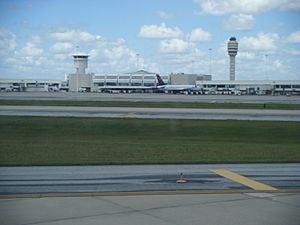
Florida has 131 public airports. Florida's seven large hub and medium hub airports, as classified by the FAA, are the following:
| City served | Code | Airport name | FAA Category |
Enplanements |
|---|---|---|---|---|
| Orlando | MCO | Orlando International Airport | Large Hub | 21,565,448 |
| Miami | MIA | Miami International Airport | Large Hub | 20,709,225 |
| Fort Lauderdale | FLL | Fort Lauderdale–Hollywood Int'l Airport | Large Hub | 15,817,043 |
| Tampa | TPA | Tampa International Airport | Large Hub | 9,548,580 |
| Fort Myers | RSW | Southwest Florida International Airport | Medium Hub | 4,364,224 |
| West Palm Beach | PBI | Palm Beach International Airport | Medium Hub | 3,110,450 |
| Jacksonville | JAX | Jacksonville International Airport | Medium Hub | 2,701,861 |
Intercity rail
- Brightline is a diesel–electric higher-speed rail system. Service runs from MiamiCentral station in downtown Miami to the Orlando International Airport Intermodal Terminal in Orlando with stops in West Palm Beach, Boca Raton, Fort Lauderdale, and Aventura.
- Florida is also served by Amtrak, operating numerous lines throughout, connecting the state's largest cities to points north in the United States and Canada. The busiest Amtrak train stations in Florida in 2011 were: Sanford (259,944), Orlando (179,142), Tampa Union Station (140,785), Miami (94,556), and Jacksonville (74,733). Sanford, in Greater Orlando, is the southern terminus of the Auto Train, which originates at Lorton, Virginia, south of Washington, D.C. Until 2005, Orlando was also the eastern terminus of the Sunset Limited, which travels across the southern United States via New Orleans, Houston, and San Antonio to its western terminus of Los Angeles. Florida is served by two additional Amtrak trains (the Silver Star and the Silver Meteor), which operate between New York City and Miami. MiamiCentral in Greater Downtown Miami and the Miami Intermodal Center near Miami International Airport are major hubs for rapid transit, commuter rail, intercity rail, and buses.
Public transit

- Miami: Miami's public transportation is served by Miami-Dade Transit that runs Metrorail, a heavy rail rapid transit system, Metromover, a people mover train system in Downtown Miami, and Metrobus, Miami's bus system. Metrorail runs throughout Miami-Dade County and has two lines and 23 stations connecting to Downtown Miami's Metromover and Tri-Rail. Metromover has three lines and 21 stations throughout Downtown Miami. Outside of Miami-Dade County, public transit in the Miami metropolitan area is served by Broward County Transit and Palm Tran; intercounty commuter rail service is provided by Tri-Rail, with 18 stations including the region's three international airports.
- Orlando: Orlando is served by the SunRail commuter train, which runs on a 32 miles (51 km) (61 miles (98 km) when complete) line including four stops in downtown. Lynx bus serves the greater Orlando area in Orange, Seminole, and Osceola counties.
- Tampa: Tampa and its surrounding area use the Hillsborough Area Regional Transit Authority system ("HART"). In addition, downtown Tampa has continuous trolley services in the form of a heritage trolley powered by Tampa Electric Company. Pinellas County and St. Petersburg provide similar services through the Pinellas Suncoast Transit Authority or "PSTA". The beaches of Pinellas County also have a continuous trolley bus. Downtown St. Petersburg has a trolley system.
- Jacksonville: Jacksonville is served by the Jacksonville Skyway, an automated people mover monorail connecting the Florida State College downtown campus, the Northbank central business district, Convention Center, and Southbank locations. The system includes eight stops connected by two lines. JTA bus has 180 vehicles with 56 lines.
Sports

Florida has three NFL teams, two MLB teams, two NBA teams, two NHL teams, and two MLS teams. Florida gained its first permanent major-league professional sports team in 1966 when the American Football League added the Miami Dolphins. Florida has given professional sports franchises some subsidies in the form of tax breaks since 1991.
About half of all Major League Baseball teams conduct spring training in the state, with teams informally organized into the "Grapefruit League". Throughout MLB history, other teams have held spring training in Florida.
NASCAR (headquartered in Daytona Beach) begins all three of its major auto racing series in Florida at Daytona International Speedway in February, featuring the Daytona 500. Daytona also has the Coke Zero Sugar 400 NASCAR race weekend in August. NASCAR also has a race weekend at Homestead-Miami Speedway in Homestead in October. The 24 Hours of Daytona is one of the world's most prestigious endurance auto races. The Grand Prix of St. Petersburg and Grand Prix of Miami have held IndyCar races as well.
Florida is a major golf hub. The PGA of America is headquartered in Palm Beach Gardens, the PGA Tour is headquartered in Ponte Vedra Beach (a Jacksonville suburb) and the LPGA is headquartered in Daytona Beach. The Players Championship, WGC-Cadillac Championship, Arnold Palmer Invitational, Honda Classic and Valspar Championship are PGA Tour rounds.
Florida has teams in all five American major league sports. Florida's most recent major-league team, Inter Miami, began play in MLS in 2020.
The Miami Masters is an ATP World Tour Masters 1000 and WTA Premier tennis event, whereas the Delray Beach International Tennis Championships is an ATP World Tour 250 event.
There are minor league baseball, football, basketball, ice hockey, soccer and indoor football teams based in Florida. Ben Hill Griffin Stadium is the largest football stadium in Florida, the 12th-largest stadium in college football, and the 18th-largest stadium in the world, as measured by its official seating capacity of 88,548—though, it has often held over 90,000 for Florida's home football games.
Florida's universities have a number of collegiate sport programs. Major college football programs include the Florida State Seminoles and Miami Hurricanes of the Atlantic Coast Conference, and the Florida Gators of the Southeastern Conference. Since 1996, Florida has added four additional teams to the ranks of Division I FBS: UCF Knights, South Florida Bulls, Florida Atlantic Owls and FIU Panthers.
State symbols
The majority of the symbols were chosen after 1950; only the two oldest symbols—the state flower (chosen in 1909), and the state bird (chosen in 1927), and the state nickname (chosen in 1970)—are not listed in the 2010 Florida Statutes.
- Amphibian: Barking tree frog
- Animal: Florida panther
- Anthem: "Florida (Where the Sawgrass Meets the Sky)"
- Beverage: Orange juice
- Bird: Northern mockingbird
- Bird: American flamingo
- Festival: "Calle Ocho-Open House 8"
- Fish
(fresh water): Florida largemouth bass - Fish
(salt water): Atlantic sailfish - Flower: Orange blossom
- Fruit: Orange
- Gem: Moonstone
- Horse: Florida Cracker Horse
- Insect: Zebra longwing
- Mammal
(salt water): Common bottlenose dolphin - Mammal
(marine): Florida manatee - Motto: "In God We Trust"
- Nickname: The Sunshine State
- Palm Tree: Coconut palm
- Pie: Key lime pie
- Play: Cross and Sword
- Reptile: American alligator
- Reptile
(salt water): Loggerhead sea turtle - Rodeo: Silver Spurs Rodeo
- Shell: Horse conch
- Soil: Myakka soil
- Song: "Old Folks at Home"
- State day/week: Pascua Florida
- Stone: Agatized coral
- Tortoise: Gopher tortoise
- Tree: Sabal palmetto
- Wildflower: Tickseed
Sister states
| Sister jurisdiction | Country | Year |
|---|---|---|
| Languedoc-Roussillon | 1989 | |
| Taiwan Province | 1992 | |
| Wakayama Prefecture | 1995 | |
| Western Cape | 1995 | |
| Nueva Esparta | 1999 | |
| Kyonggi | 2000 |
See also
 In Spanish: Florida para niños
In Spanish: Florida para niños



